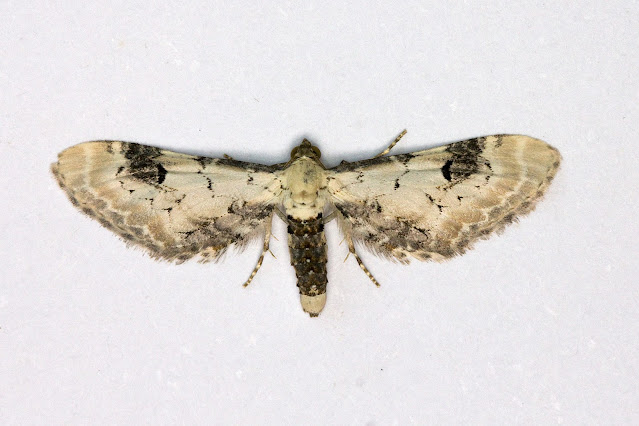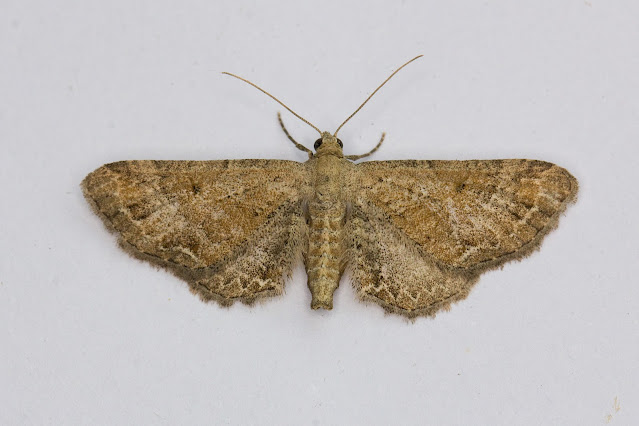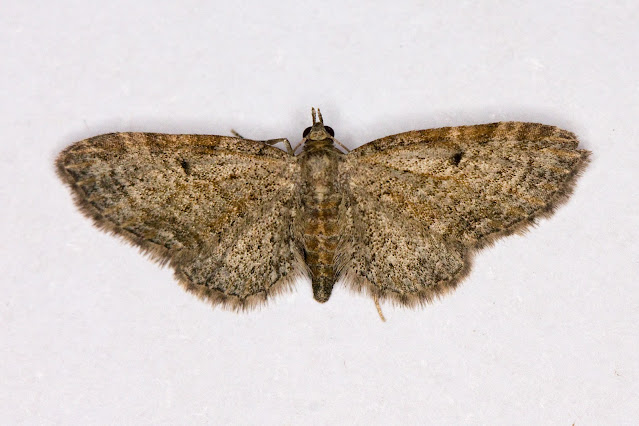Pugs, small moths, mostly between 1.5 and 3.0cms wingspan. There are around sixty individual species found within the UK and most are difficult to identify. They do have diagnostic features but individual moths are very variable and there is a lot of overlap between species. Several of the species also have melanic (dark/black) forms that look nothing like the normal form. Pristine specimens help but Pug moths seem to age and become worn very quickly and the features you are looking for are hard to distinguish.
I always struggle with these moths but there comes a time when you have to commit to putting names to pictures. However, please be aware that I am not an expert and treat the information given here with a degree of caution
So, perhaps its best to start with the ones I am sure about. Green Pug, V-Pug, Lime-Spec Pug, Cypress Pug, etc. All are very distinctive and it would be difficult to make a mistake.
 |
| Green Pug - Pasiphila rectangulata |
 |
| V-Pug - Chloroclystis v-ata |
 |
| Lime-spec Pug - Eupithecia centaureata |
 |
Cypress Pug - Eupithecia pusillata
|
Next is the Double-striped Pug. It is fairly straight forward, probably because I see more of these than any other Pug.
It has quite distinctive white and red/brown cross lines and the dark abdominal band. It also has a distinctive wing shape with pointed tips and I usually find that even when worn the dark patches on the tip/outer edge of the forewing can still be seen.
 |
| Double-striped Pug - Gymnoscelis rufifasciata |
The moth often sits with its wings out and the leading edges held in a straight line. This together with the distinctive shape makes it easy to identify even the worn specimens.
.jpg) |
| Double-striped Pug - Gymnoscelis rufifasciata |
The Foxglove and Toadflax Pugs are similar but reasonably easy to tell apart. The Toadflax is slightly smaller with more rounded wings and with a brighter and more contrasty appearance. Key features to look for are the Toadflax having a more uniformly dark central band whilst the Foxglove band looks a patchy grey. Best of all, the outer edge of the central dark band of the Toadflax meets the leading edge of the wing at an angle of ninety degrees whilst on the Foxglove the edge is sharply angled in.
 |
| Foxglove Pug - Eupithecia pulchellata |
 |
| Toadflax Pug - Eupithecia linariata |
Then we get onto the ones where I have had to do a bit more work and where there is still an element of doubt.
It took me some time to get to grips with the Freyer's Pug. I only had the worn example below and it didn't look much like the picture in the field Guide for Eupithecia intricata, even the base colour looked wrong. However, searching the web there were a number of close matches to this picture that were labelled up as Freyer's and it did look similar to one of the other sub species milliera (Edinburgh Pug) which is more prevalent in the north of the country.
 |
Freyer's Pug - Eupithecia intricata
|
A recent catch in better condition gives a better illustration of the key characteristics such as elongated central spot dark brown or blackish band near the base of the abdomen and dark brown and white chequering on the veins in the central area.
 |
Freyer's Pug - Eupithecia intricata
|
The next a Channel Islands Pug. Wingspan 14mm, shape and wing markings look reasonable, elongated discal spot but perhaps this is a bit broader than I would like. It looks good because of the size but then I doubt that size by itself is diagnostic. I have had a number of these dark forms but would really like a lighter form to be able to see the markings more clearly. Please note, this picture has been slightly over exposed to get some detail on the wings.
 |
| Channel Islands Pug - Eupithecia ultimaria |
Brindled Pugs and Oak-tree Pugs. There seems to be a considerable overlap between these two species so can I differentiate between the two pictures below.
I've called the first an Oak-tree Pug it has more rounded wings, a bit brighter appearance, smaller discal spots and white patches just outside the discal spots. On the second it looks like an Oak-tree but it seems to have longer and more slender wings and no white patches, so I am thinking Brindled but when you measure the wings, there really is no difference between the two.
Am I confident with the identifications? With the first as an Oak-tree yes but with the second no, not really, it's all a bit subjective but you have to try. When I started the blog I would have said Brindled, looking at it now I favour Oak-tree.
 |
| Oak-tree Pug - Eupithecia dodoneata |
 |
| Oak-tree or Brindled Pug ? |
And below a Brindled Pug. This one badly worn but on wing shape and the markings that are left it looks good for Brindled. Note the long narrow discal spots.
 |
| Brindled Pug - Eupithecia abbreviata |
As far as I know I have only ever caught one Plain Pug. It seems straight forward to identify. Large Pug with a brown colour, small discal spots and a pale wavy line along the outer margin of both the front and hind wings.
 |
| Plain Pug - Eupithecia simpliciata |
The next one I was trying to make into a Maple Pug because of its yellowish background but the arguments were not convincing. I now think it is probably a Grey Pug, fine cross lines, small discal spots and small tonal spots. However I have a low confidence level on this one.
 |
| Is it a Grey Pug? |
For comparison the one below is a Grey Pug.
 |
| Grey Pug - Eupithecia subfuscata |
Then we get a bunch of Pugs with reddish brown wings, dark abdominal bands and white tonal spots. The guide books tend to show pristine examples with clear markings but that is not what I get in my trap. So how do we differentiate between them?
Common Pug - reddish brown background, very small or absent discal spots, and a pale wavy line parallel to the outer edge of the forewing and ending in a white tornal spot.
 |
| Common Pug - Eupithecia vulgata |
This next one a better marked Common Pug
 |
| Common Pug - Eupithecia vulgata |
Currant Pug - I originally labelled this as a Wormwood Pug but changed it to Currant Pug based on the shape of the wing, wider and more rounded than the Wormwood, more prominent tonal spots, larger more oblong discal spots and dark markings along the leading edge of the wing.
 |
| Currant Pug - Eupithecia assimilata |
 |
| Currant Pug |
White-spotted Pug - Fortunately this specimen is still reasonably fresh. It shows two white spots on the trailing edge of both fore and aft wings and two white spots on each side of the abdomen.
 |
| White-spotted Pug - Eupithecia tripunctaria |
Another easy one, Haworth's Pug. Not much to distinguish it in the way of markings on the wing but the orange/yellow shading on the body seems to be diagnostic.
 |
| Haworth's Pug - Eupithecia haworthiata |
 |
| Haworth's Pug - Eupithecia haworthiata |
The next a Slender Pug? Wingspan 18mm, rounded wings small but prominent dot like discal spots and a pale greyish brown background. Not much to go on but the markings on the wing look similar to examples of the Slender Pug that I have found on the web.
 |
| Slender Plug - Eupithecia tenuiata |
and if you are not convinced try this one as a Slender Pug
 |
| Slender Plug - Eupithecia tenuiata |
So, around a quarter of the UK pugs caught in the garden trap and hopefully identified. Previously I hated getting the Pugs. It seemed like an impossible task to identify them. Now it's the first thing I look for. The more you see the more you need to learn.
Do you really need to put up with the agro of a birding twitch when you can have the joy of twitching a new Pug moth and have it all to yourself to identify?
Do I have any tips. There are a couple of good websites that I often turn to and it's probably worth getting a copy of Brian Hancock's Pug Moths of North West England. It is the wrong part of the country for me but the tips on identification are invaluable. The best tip I can give is always note the wingspan on any pug you see. It can really help in firming up on an identification.
Hopefully I have labelled these pugs correctly but if you have any suggestions for corrections please let me know.




.jpg)
































































